Yu-Chee Tseng
Block-based Symmetric Pruning and Fusion for Efficient Vision Transformers
Jul 16, 2025Abstract:Vision Transformer (ViT) has achieved impressive results across various vision tasks, yet its high computational cost limits practical applications. Recent methods have aimed to reduce ViT's $O(n^2)$ complexity by pruning unimportant tokens. However, these techniques often sacrifice accuracy by independently pruning query (Q) and key (K) tokens, leading to performance degradation due to overlooked token interactions. To address this limitation, we introduce a novel {\bf Block-based Symmetric Pruning and Fusion} for efficient ViT (BSPF-ViT) that optimizes the pruning of Q/K tokens jointly. Unlike previous methods that consider only a single direction, our approach evaluates each token and its neighbors to decide which tokens to retain by taking token interaction into account. The retained tokens are compressed through a similarity fusion step, preserving key information while reducing computational costs. The shared weights of Q/K tokens create a symmetric attention matrix, allowing pruning only the upper triangular part for speed up. BSPF-ViT consistently outperforms state-of-the-art ViT methods at all pruning levels, increasing ImageNet classification accuracy by 1.3% on DeiT-T and 2.0% on DeiT-S, while reducing computational overhead by 50%. It achieves 40% speedup with improved accuracy across various ViTs.
DaMO: A Data-Efficient Multimodal Orchestrator for Temporal Reasoning with Video LLMs
Jun 13, 2025Abstract:Large Language Models (LLMs) have recently been extended to the video domain, enabling sophisticated video-language understanding. However, existing Video LLMs often exhibit limitations in fine-grained temporal reasoning, restricting their ability to precisely attribute responses to specific video moments, especially under constrained supervision. We introduce DaMO, a data-efficient Video LLM explicitly designed for accurate temporal reasoning and multimodal understanding. At its core, the proposed Temporal-aware Fuseformer employs a hierarchical dual-stream architecture that progressively captures temporal dynamics within each modality and effectively fuses complementary visual and audio information. To further enhance computational efficiency, DaMO integrates a global residual that reduces spatial redundancy while preserving essential semantic details. We train DaMO via a structured four-stage progressive training paradigm, incrementally equipping the model with multimodal alignment, semantic grounding, and temporal reasoning capabilities. This work also contributes multiple datasets augmented from existing ones with GPT-generated temporally grounded QA pairs for tasks requiring temporal supervision. Comprehensive experiments on temporal grounding and video QA benchmarks demonstrate that DaMO consistently surpasses prior methods, particularly in tasks demanding precise temporal alignment and reasoning. Our work establishes a promising direction for data-efficient video-language modeling.
GCC: Generative Color Constancy via Diffusing a Color Checker
Feb 24, 2025Abstract:Color constancy methods often struggle to generalize across different camera sensors due to varying spectral sensitivities. We present GCC, which leverages diffusion models to inpaint color checkers into images for illumination estimation. Our key innovations include (1) a single-step deterministic inference approach that inpaints color checkers reflecting scene illumination, (2) a Laplacian decomposition technique that preserves checker structure while allowing illumination-dependent color adaptation, and (3) a mask-based data augmentation strategy for handling imprecise color checker annotations. GCC demonstrates superior robustness in cross-camera scenarios, achieving state-of-the-art worst-25% error rates of 5.15{\deg} and 4.32{\deg} in bi-directional evaluations. These results highlight our method's stability and generalization capability across different camera characteristics without requiring sensor-specific training, making it a versatile solution for real-world applications.
SpectroMotion: Dynamic 3D Reconstruction of Specular Scenes
Oct 22, 2024Abstract:We present SpectroMotion, a novel approach that combines 3D Gaussian Splatting (3DGS) with physically-based rendering (PBR) and deformation fields to reconstruct dynamic specular scenes. Previous methods extending 3DGS to model dynamic scenes have struggled to accurately represent specular surfaces. Our method addresses this limitation by introducing a residual correction technique for accurate surface normal computation during deformation, complemented by a deformable environment map that adapts to time-varying lighting conditions. We implement a coarse-to-fine training strategy that significantly enhances both scene geometry and specular color prediction. We demonstrate that our model outperforms prior methods for view synthesis of scenes containing dynamic specular objects and that it is the only existing 3DGS method capable of synthesizing photorealistic real-world dynamic specular scenes, outperforming state-of-the-art methods in rendering complex, dynamic, and specular scenes.
MP-PolarMask: A Faster and Finer Instance Segmentation for Concave Images
Jun 03, 2024Abstract:While there are a lot of models for instance segmentation, PolarMask stands out as a unique one that represents an object by a Polar coordinate system. With an anchor-box-free design and a single-stage framework that conducts detection and segmentation at one time, PolarMask is proved to be able to balance efficiency and accuracy. Hence, it can be easily connected with other downstream real-time applications. In this work, we observe that there are two deficiencies associated with PolarMask: (i) inability of representing concave objects and (ii) inefficiency in using ray regression. We propose MP-PolarMask (Multi-Point PolarMask) by taking advantage of multiple Polar systems. The main idea is to extend from one main Polar system to four auxiliary Polar systems, thus capable of representing more complicated convex-and-concave-mixed shapes. We validate MP-PolarMask on both general objects and food objects of the COCO dataset, and the results demonstrate significant improvement of 13.69% in AP_L and 7.23% in AP over PolarMask with 36 rays.
Scale-Aware Crowd Count Network with Annotation Error Correction
Dec 28, 2023Abstract:Traditional crowd counting networks suffer from information loss when feature maps are downsized through pooling layers, leading to inaccuracies in counting crowds at a distance. Existing methods often assume correct annotations during training, disregarding the impact of noisy annotations, especially in crowded scenes. Furthermore, the use of a fixed Gaussian kernel fails to account for the varying pixel distribution with respect to the camera distance. To overcome these challenges, we propose a Scale-Aware Crowd Counting Network (SACC-Net) that introduces a ``scale-aware'' architecture with error-correcting capabilities of noisy annotations. For the first time, we {\bf simultaneously} model labeling errors (mean) and scale variations (variance) by spatially-varying Gaussian distributions to produce fine-grained heat maps for crowd counting. Furthermore, the proposed adaptive Gaussian kernel variance enables the model to learn dynamically with a low-rank approximation, leading to improved convergence efficiency with comparable accuracy. The performance of SACC-Net is extensively evaluated on four public datasets: UCF-QNRF, UCF CC 50, NWPU, and ShanghaiTech A-B. Experimental results demonstrate that SACC-Net outperforms all state-of-the-art methods, validating its effectiveness in achieving superior crowd counting accuracy.
Tracking Players in a Badminton Court by Two Cameras
Aug 09, 2023Abstract:This study proposes a simple method for multi-object tracking (MOT) of players in a badminton court. We leverage two off-the-shelf cameras, one on the top of the court and the other on the side of the court. The one on the top is to track players' trajectories, while the one on the side is to analyze the pixel features of players. By computing the correlations between adjacent frames and engaging the information of the two cameras, MOT of badminton players is obtained. This two-camera approach addresses the challenge of player occlusion and overlapping in a badminton court, providing player trajectory tracking and multi-angle analysis. The presented system offers insights into the positions and movements of badminton players, thus serving as a coaching or self-training tool for badminton players to improve their gaming strategies.
Scale-Aware Crowd Counting Using a Joint Likelihood Density Map and Synthetic Fusion Pyramid Network
Nov 13, 2022Abstract:We develop a Synthetic Fusion Pyramid Network (SPF-Net) with a scale-aware loss function design for accurate crowd counting. Existing crowd-counting methods assume that the training annotation points were accurate and thus ignore the fact that noisy annotations can lead to large model-learning bias and counting error, especially for counting highly dense crowds that appear far away. To the best of our knowledge, this work is the first to properly handle such noise at multiple scales in end-to-end loss design and thus push the crowd counting state-of-the-art. We model the noise of crowd annotation points as a Gaussian and derive the crowd probability density map from the input image. We then approximate the joint distribution of crowd density maps with the full covariance of multiple scales and derive a low-rank approximation for tractability and efficient implementation. The derived scale-aware loss function is used to train the SPF-Net. We show that it outperforms various loss functions on four public datasets: UCF-QNRF, UCF CC 50, NWPU and ShanghaiTech A-B datasets. The proposed SPF-Net can accurately predict the locations of people in the crowd, despite training on noisy training annotations.
CoachAI: A Project for Microscopic Badminton Match Data Collection and Tactical Analysis
Jul 12, 2019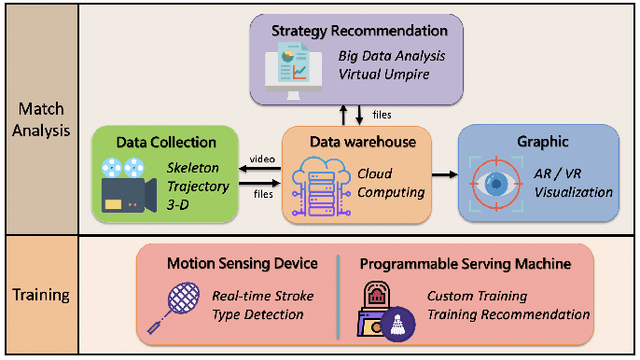
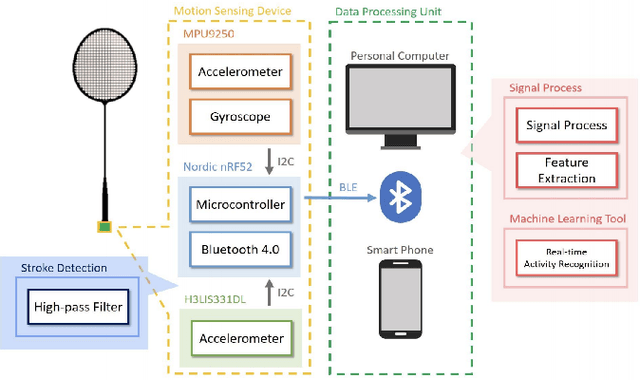
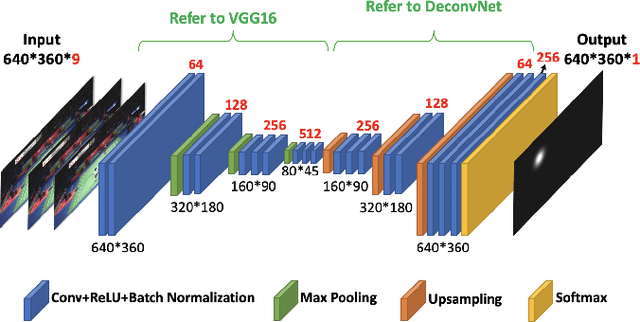
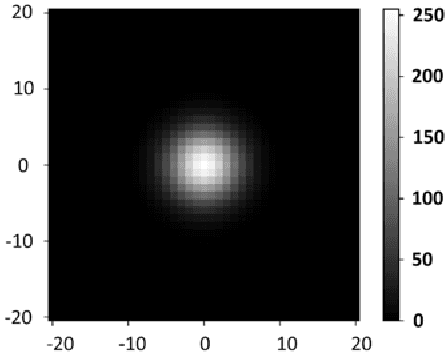
Abstract:Computer vision based object tracking has been used to annotate and augment sports video. For sports learning and training, video replay is often used in post-match review and training review for tactical analysis and movement analysis. For automatically and systematically competition data collection and tactical analysis, a project called CoachAI has been supported by the Ministry of Science and Technology, Taiwan. The proposed project also includes research of data visualization, connected training auxiliary devices, and data warehouse. Deep learning techniques will be used to develop video-based real-time microscopic competition data collection based on broadcast competition video. Machine learning techniques will be used to develop a tactical analysis. To reveal data in more understandable forms and to help in pre-match training, AR/VR techniques will be used to visualize data, tactics, and so on. In addition, training auxiliary devices including smart badminton rackets and connected serving machines will be developed based on the IoT technology to further utilize competition data and tactical data and boost training efficiency. Especially, the connected serving machines will be developed to perform specified tactics and to interact with players in their training.
Fusing Video and Inertial Sensor Data for Walking Person Identification
Feb 20, 2018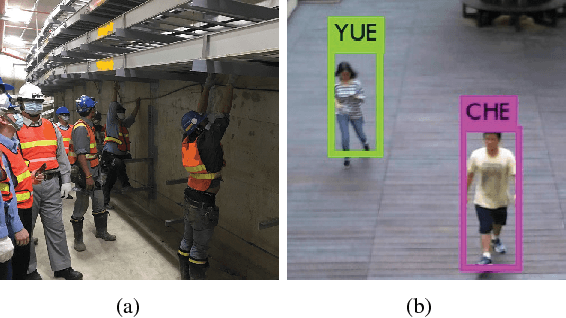

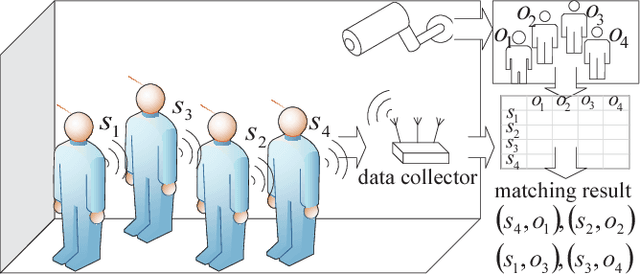
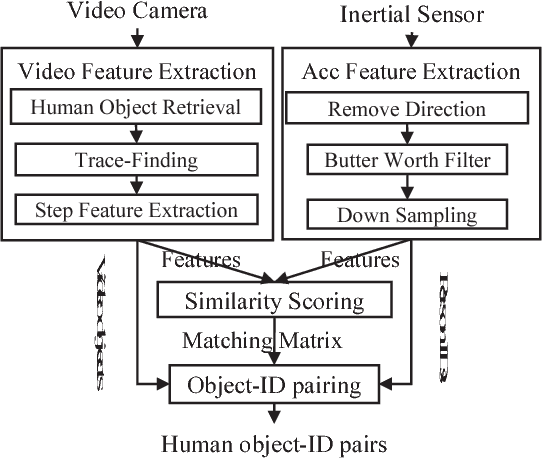
Abstract:An autonomous computer system (such as a robot) typically needs to identify, locate, and track persons appearing in its sight. However, most solutions have their limitations regarding efficiency, practicability, or environmental constraints. In this paper, we propose an effective and practical system which combines video and inertial sensors for person identification (PID). Persons who do different activities are easy to identify. To show the robustness and potential of our system, we propose a walking person identification (WPID) method to identify persons walking at the same time. By comparing features derived from both video and inertial sensor data, we can associate sensors in smartphones with human objects in videos. Results show that the correctly identified rate of our WPID method can up to 76% in 2 seconds.
 Add to Chrome
Add to Chrome Add to Firefox
Add to Firefox Add to Edge
Add to Edge